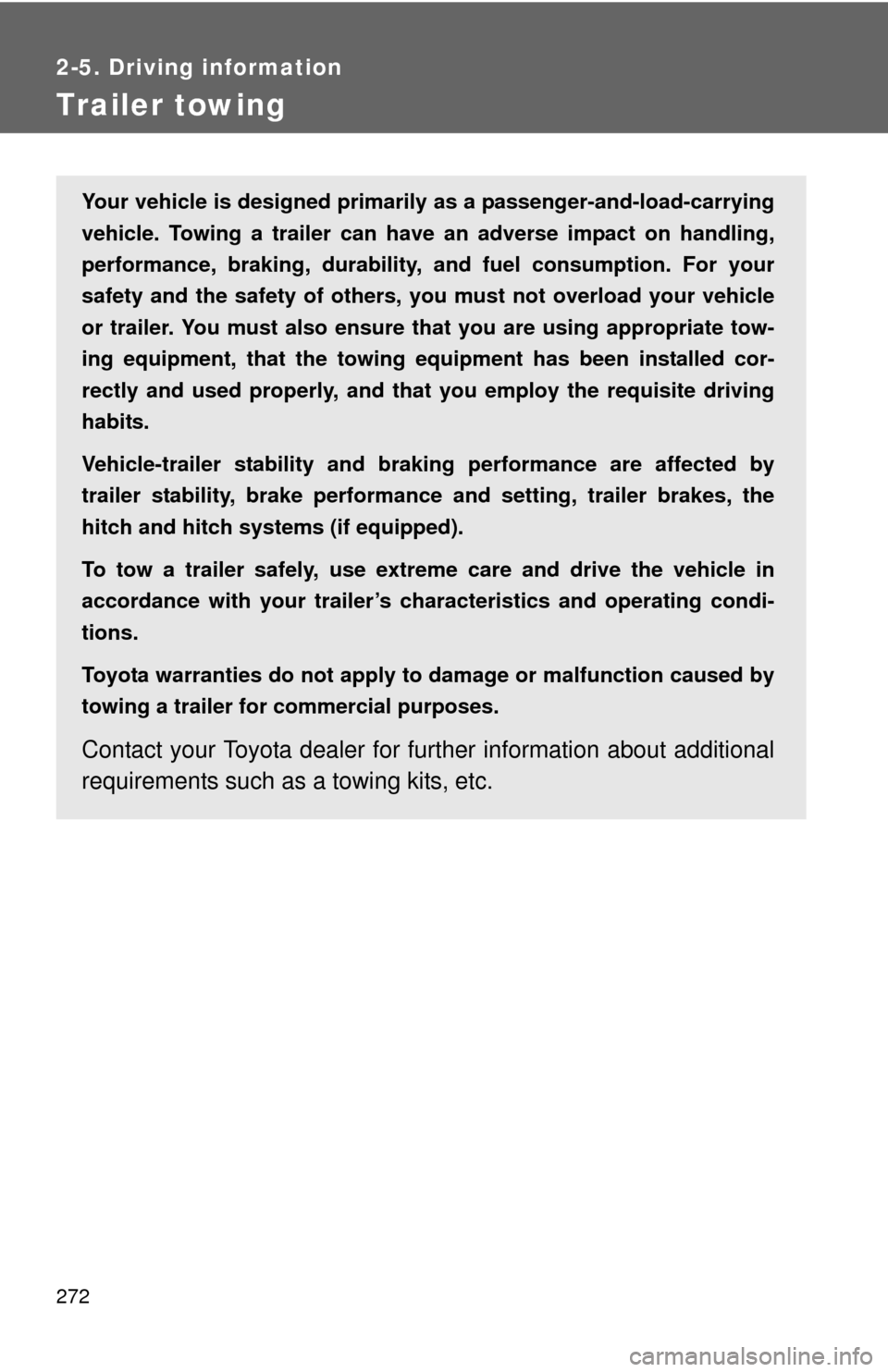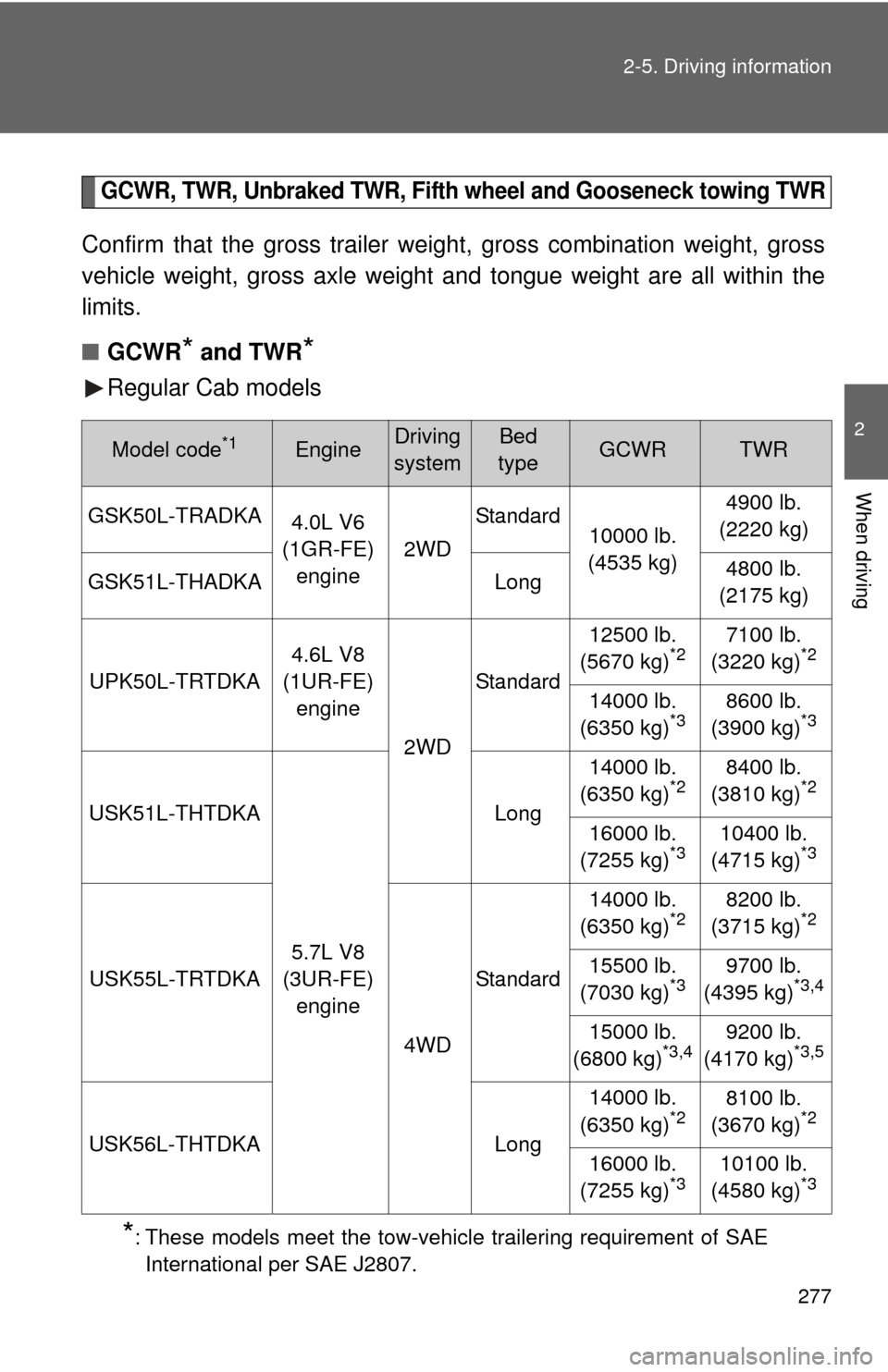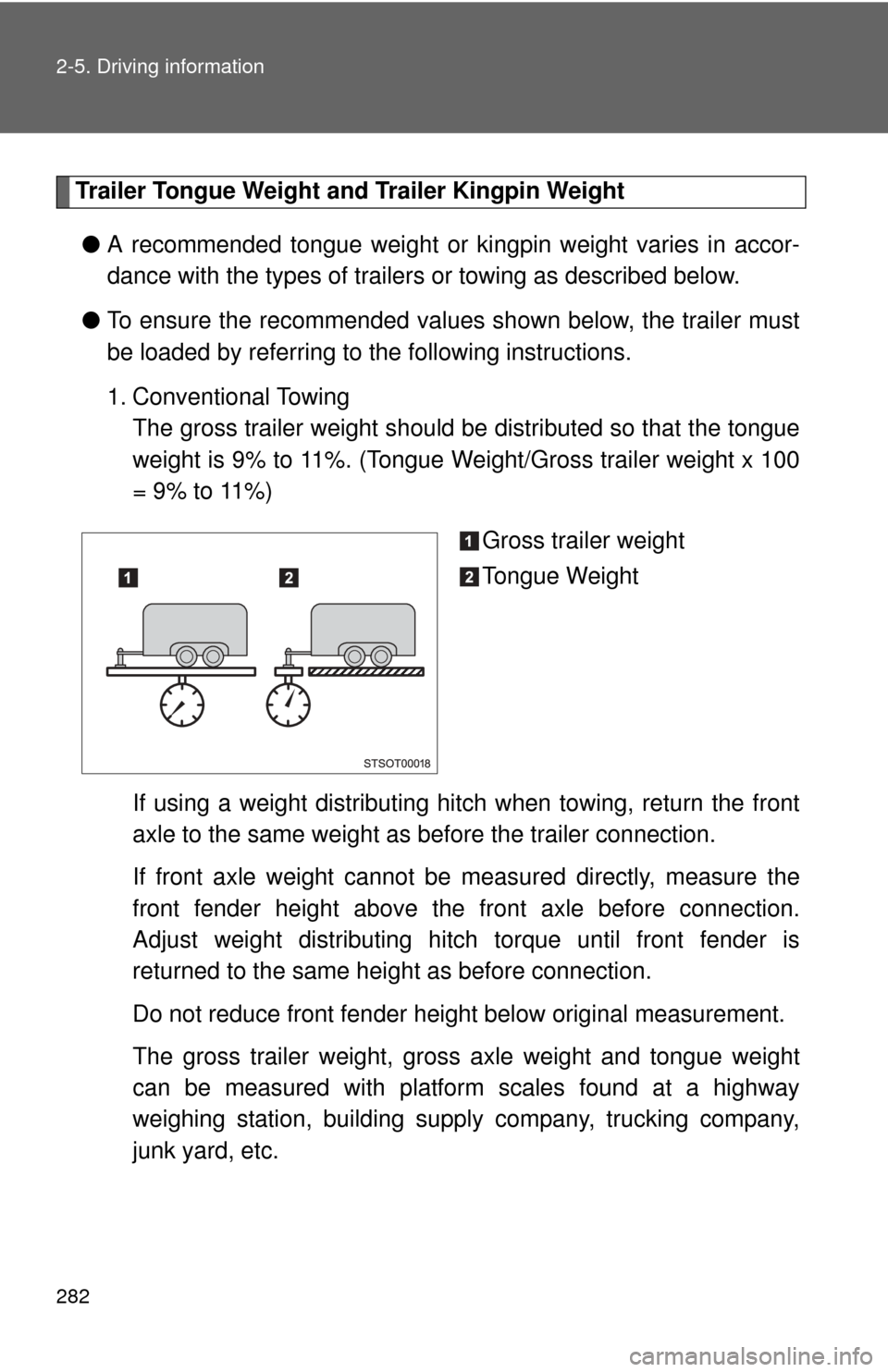Page 272 of 752

272
2-5. Driving information
Trailer towing
Your vehicle is designed primarily as a passenger-and-load-carrying
vehicle. Towing a trailer can have an adverse impact on handling,
performance, braking, durability, and fuel consumption. For your
safety and the safety of others, yo u must not overload your vehicle
or trailer. You must also ensure that you are using appropriate tow-
ing equipment, that the towing eq uipment has been installed cor-
rectly and used properly, and that you employ the requisite driving
habits.
Vehicle-trailer stability and br aking performance are affected by
trailer stability, brake performan ce and setting, trailer brakes, the
hitch and hitch systems (if equipped).
To tow a trailer safely, use extreme care and drive the vehicle in
accordance with your trailer’s characteristics and operating condi-
tions.
Toyota warranties do not apply to damage or malfunction caused by
towing a trailer for commercial purposes.
Contact your Toyota dealer for fu rther information about additional
requirements such as a towing kits, etc.
Page 273 of 752
273
2-5. Driving information
2
When driving
Towing related terms
■ GCWR (Gross Combination Weight Rating)
The maximum allowable gross
combination weight. The gross
combination weight is the sum of
the total vehicle weight (including
the occupants, cargo and any
optional equipment installed on
the vehicle) and the weight of the
trailer being towed (including the
cargo in the trailer).
■ GVWR (Gross Vehicle Weight Rating)
The maximum allowable gross
vehicle weight. The gross vehicle
weight is the total weight of the
vehicle. When towing a trailer, it
is the sum of the vehicle weight
(including the occupants, cargo
and any optional equipment
installed on the vehicle) and the
tongue weight.
Page 274 of 752
274 2-5. Driving information
■GAWR (Gross Axle Weight Rating)
The maximum allowable gross
axle weight. The gross axle
weight is the load placed on
each axle (front and rear).
■ TWR (Trailer Weight Rating)
The maximum allowable gross
trailer weight. The gross trailer
weight is the sum of the trailer
weight and the weight of the
cargo in the trailer.
TWR is calculated assuming
base vehicle with one driver, one
front passenger, towing package
(if available), hitch and hitch sys-
tems (if required).
Additional optional equipment,
passengers and cargo in the vehi-
cle will reduce the trailer weight
rating so as not to exceed
GCWR, GVWR and GAWR.
If the gross trailer weight exceeds
3000 lb. (1360 kg), it is recom-
mended to use a trailer with 2 or
more axles.
Front GAWR
Rear GAWR
(With brakes)
Page 275 of 752
275
2-5. Driving information
2
When driving
■
Unbraked TWR (Unbraked Trailer Weight Rating)
The trailer weight rating for tow-
ing a trailer without a trailer ser-
vice brake system.
■ Tongue Weight
The load placed on the trailer
hitch ball. (P. 282)
■ Kingpin Weight
The load placed on the 5th wheel
mount or the gooseneck ball.
( P. 282)
(Without brakes)
Page 276 of 752
276 2-5. Driving information
Weight limits● The gross trailer weight must never exceed the TWR described in
the table. ( P. 277, 669)
● The gross combination weight must never exceed the GCWR
described in the table. ( P. 277)
●The gross vehicle weight must
never exceed the GVWR indi-
cated on the Certification
Label.
● The gross axle weight on each
axle must never exceed the
GAWR indicated on the Certi-
fication Label.
● If the gross trailer weight is over the unbraked TWR, trailer service
brakes are required.
● If the gross trailer weight is over 2000 lb. (907 kg), a sway control
device with sufficient capacity is required.
● If the gross trailer weight is over 5000 lb. (2268 kg), a weight dis-
tributing hitch with sufficient capacity is required.
Page 277 of 752

277
2-5. Driving information
2
When driving
GCWR, TWR, Unbraked TWR, Fifth wheel and Gooseneck towing TWR
Confirm that the gross trailer weight, gross combination weight, gross
vehicle weight, gross axle weight and tongue weight are all within the
limits.
■
GCWR
* and TWR*
Regular Cab models
*: These models meet the tow-vehicle trailering requirement of SAE
International per SAE J2807.
Model code*1EngineDriving
systemBed
typeGCWRTWR
GSK50L-TRADKA 4.0L V6
(1GR-FE) engine 2WDStandard
10000 lb.
(4535 kg) 4900 lb.
(2220 kg)
GSK51L-THADKA Long 4800 lb.
(2175 kg)
UPK50L-TRTDKA 4.6L V8
(1UR-FE) engine
2WDStandard
12500 lb.
(5670 kg)
*27100 lb.
(3220 kg)*2
14000 lb.
(6350 kg)*38600 lb.
(3900 kg)*3
USK51L-THTDKA
5.7L V8
(3UR-FE) engine Long
14000 lb.
(6350 kg)
*28400 lb.
(3810 kg)*2
16000 lb.
(7255 kg)*310400 lb.
(4715 kg)*3
USK55L-TRTDKA
4WDStandard 14000 lb.
(6350 kg)
*28200 lb.
(3715 kg)*2
15500 lb.
(7030 kg)*39700 lb.
(4395 kg)*3,4
15000 lb.
(6800 kg)*3,49200 lb.
(4170 kg)*3,5
USK56L-THTDKA Long14000 lb.
(6350 kg)
*28100 lb.
(3670 kg)*2
16000 lb.
(7255 kg)*310100 lb.
(4580 kg)*3
Page 281 of 752
281
2-5. Driving information
2
When driving
*1: The model code is indicated on the Certification Label. (P. 672)*2: Without towing package*3: With towing package
■
Unbraked TWR*
1000 lb. (453 kg)
USK56L-PSTSGA
5.7L V8
(3UR-FBE) engine 4WD Short 14000 lb.
(6350 kg)
*27700 lb.
(3490 kg)*2
15300 lb.
(6940 kg)*39000 lb.
(4080 kg)*3
USK56L-PSTLGA 14000 lb.
(6350 kg)
*27700 lb.
(3490 kg)*2
15300 lb.
(6940 kg)*39000 lb.
(4080 kg)*3
*: These models meet the tow-vehicle trailering requirement of SAE International per SAE J2807.
Model code*1EngineDriving
systemBed
typeGCWRTWR
Page 282 of 752

282 2-5. Driving information
Trailer Tongue Weight and Trailer Kingpin Weight● A recommended tongue weight or kingpin weight varies in accor-
dance with the types of trailers or towing as described below.
● To ensure the recommended values shown below, the trailer must
be loaded by referring to the following instructions.
1. Conventional Towing
The gross trailer weight should be distributed so that the tongue
weight is 9% to 11%. (Tongue Weight/Gross trailer weight x 100
= 9% to 11%)
Gross trailer weight
Tongue Weight
If using a weight distributing hitch when towing, return the front
axle to the same weight as before the trailer connection.
If front axle weight cannot be measured directly, measure the
front fender height above th e front axle before connection.
Adjust weight distributing hitch torque until front fender is
returned to the same height as before connection.
Do not reduce front fender height below original measurement.
The gross trailer weight, gross axle weight and tongue weight
can be measured with platform scales found at a highway
weighing station, building supply company, trucking company,
junk yard, etc.